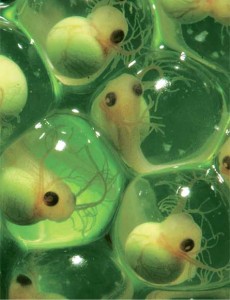Embryonic and larval development form a significant part of many species’ life history. Animal development is governed by gene expression within the cell that specifies tissues and regulates cell differentiation. However, it is increasingly being recognized that environmental factors such as temperature, photoperiod, diet, population density, or the presence of predators, play a major role in determining gene expression patterns thereby producing variation in developmental responses and phenotypes. With increasing urbanization and associated ecological changes, species might further alter their development to adapt to new environmental challenges presented by urbanization.
One example of development being affected by the environment is temperature-dependent sex determination where at one temperature, embryos become males and at another temperature, they become females. For example, in painted turtles, Chrysemys picta, the sex ratio is linked to temperature, with the sex ratio become increasingly female when temperature increases. Habitat modification during urbanization changes the temperatures of their nest sites and may lead to biased sex ratios. Anthropogenic alteration of habitats can therefore disrupt the developmental responses of animals.
Hatching of the embryos can also be affected by environmental cues such as increased presence of predators. For example, the embryos of the red-eyed tree frog, Agalychnis callidryas, sense the presence of the snake and vigorously shake in their egg cases when attacked. They hatch prematurely into the water to prevent getting eaten. However, premature hatching also means that hatchlings are at higher risk of being eaten by the aquatic predators once in the water. Variation in hatching rates is also observed in other species at different temperatures and when there are environmental contaminants. Moreover, the morphology of the tadpoles is also altered in the face of these environmental assaults. Introduction of novel predators or altered abiotic conditions caused by urbanization therefore easily influence the developmental behaviours and phenotypes of the species.
Figure 1: Embryos of the red-eyed tree frog. At early developmental stages, they are already actively responding to the environment, which is critical to its long-term survival. Source: Karen Warkentin
Video on how the embryos of red-eyed tree frog hatch prematurely, in the presence of the parrot snake as a predator, so as to escape the predator attack.
As seen, development and the environment is intrinsically linked and environmental cues play a role in determining the developmental trajectory of the species. As we become more aware of the how development is critically influenced by the environment, we are also realizing that increasing urbanization may be affecting species in more ways than we think.
What other ways do you think urbanization could be affecting developmental responses?
References:
Gilbert, S. (2001). Ecological Developmental Biology: Developmental Biology Meets the Real World. Developmental Biology 233, 1-12.
Kolbe, J., and Janzen, F. (2002). Impact of nest-site selection on nest success and nest temperature in natural and disturbed habitats. Ecology 83, 269-281.
Warkentin, K. (2005). How do embryos assess risk? Vibrational cues in predator-induced hatching of red-eyed treefrogs. Animal Behaviour 70, 59-71.
